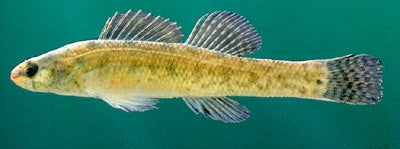SWAMP DARTER
SCIENTIFIC NAME: Etheostoma fusiforme
CHARACTERISTICS: Colors of both sexes of the swamp darter are rather subdued. The back is tan, light yellow, or green, and the venter is either white or light yellow with scattered dark pigment. The sides have about 10 to 12 brown, quadrate spots, and some individuals have a number of diffuse dorsal saddles. The fins are lightly banded or clear. Two prominent features of the swamp darter are a bar under the eye and one distinct spot at the base of the caudal fin. The lateral line is arched toward the spiny dorsal fin.
ADULT SIZE: 1.2 to 2 in (30 to 50 mm)
DISTRIBUTION: Etheostoma fusiforme is found in Atlantic and Gulf slope drainages from Maine to Louisiana. Collette (1962) recognizes two subspecies; E. f. fusiforme found from North Carolina north to Maine, and E. f. barratti found from South Carolina south to Florida and in Gulf slope drainages. Most collections of E. f. barratti in Alabama are from Baldwin, Mobile, and Washington counties in southwest Alabama. We also have scattered records from the Conecuh River system east to the Chattahoochee River system and the Alabama and Tombigbee river drainages below the Fall Line. Future sampling of preferred habitats will likely expand the known range of this lowland species.
HABITAT AND BIOLOGY: As its common name implies, E. fusiforme is a swamp-dwelling species, preferring still or slow-flowing waters over muddy and silty substrates mixed with detritus or aquatic vegetation. The tannin-stained swamps and backwaters of the Pine Hills district in southwest Alabama afford excellent habitats for swamp darters. Collette (1962) indicates a tolerance for stagnant, low-oxygenated, high-temperature waters, whereas Schmidt and Whitworth (1979) indicate a preference for vegetated ponds with detrital sediments. This latter study found that microcrustaceans were the main foods of the species, with lesser amounts of midges, mayflies, and caddisflies. Single eggs are deposited on aquatic vegetation during the months of March, April, and May. Collette (1962) reports that some populations of E. fusiforme live only one year.
ORIGINAL DESCRIPTION: Girard described the swamp darter in 1854.
ETYMOLOGY:
Etheostoma strain mouth, possibly referring to the small mouth.
Fusiforme long and cylindrical, referring to the fusiform body shape.
The copyrighted information above is from Fishes of Alabama and the Mobile Basin.






